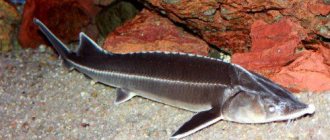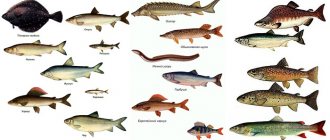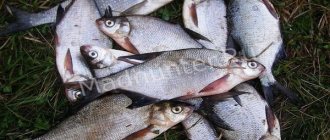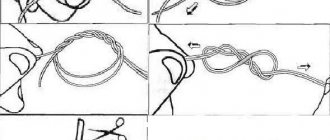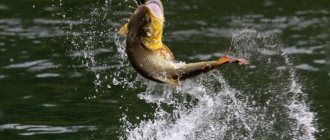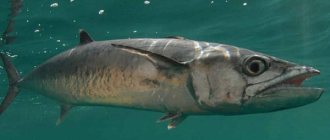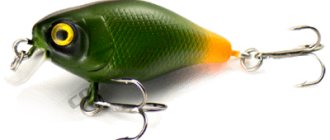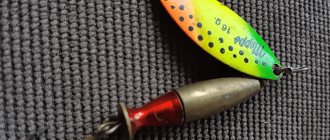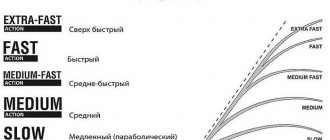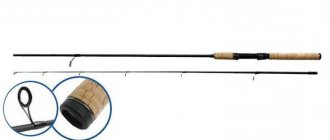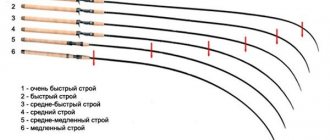Buy quality products at affordable prices in the best fishing online stores
. Give gifts to yourself and your loved ones!
we are in social networks
— subscribe to us on Facebook, Youtube, VKontakte and Instagram. Stay up to date with the latest site news.
On this page you can find out all the popular methods of fishing using various fishing gear:
- Fishing with a fishing rod
- For spinning
- Trolling
- Fishing on a feeder
- On the donk
- How to fish with a boat
- To the circle
- On the stage
- To the zherlitsa
- With an elastic band
Fishing with a fishing rod
Catching fish with a fishing rod is the oldest way of obtaining food and, probably, one of the first entertainments and hobbies of a person in those ancient and harsh centuries, when a fire, a soft skin and... a grumpy wife with children screaming in discord were waiting for the miner in a cave. The question “Where is the fish?” He was not idle; the family’s well-being, as they say now, depended on hunting and fishing. But I would like to believe that even then, in the shaggy head of the first fisherman there were not only everyday tasks of how to get food, but romance and quiet joy had already begun at the sight of the river surface, the first bite on a hook made of sharp bone, on which a caterpillar was mounted. And there was delight at the sight of a furious fish tearing on the fishing line.
The first works on amateur fishing belong to real lovers of this business in the 19th century, Leonid Pavlovich Sabaneev and Sergei Timofeevich Aksakov. The works of the scientist Sabaneev are still cited, and many postulates remain unshakable. His most famous book is the collection “Fishes of Russia”, where a large place is devoted to the float rod. The writer Aksakov can be called a romantic and ideologist of fishing with a float. It was from him that the understanding of the fishing rod began, as a means of resting the soul from everyday squabbles and escape into the bosom of Nature. His book “Notes on Fishing” is mostly devoted to the float rod, its equipment, the choice of wood for making the rod and horsehair for twisting the fishing line, as well as the making of hooks from wire and nails. After all, back then there were no nylon lines, carbon fiber and Gamakatsu hooks...
Nowadays, the modern float fishing rod has undergone numerous changes in the materials used to make the rod, and in the methods of delivering the bait to the fishing point, but the basic design and fishing trends have remained the same. As before, a fishing rod consists of a rod, fishing line, float, sinker and hook. Not long ago, this very simple scheme was the main one in the arsenal of Soviet fishermen: a bamboo rod with a wire reel on which the fishing line was wound, a float made of goose feathers, made of sedge bark, later foam and plastic, a lead sinker and a hook made of spring hardened steel. This set was a classic. Later, telescopic fishing rods appeared, where the fishing line was already wound on a wire inertial reel.
Nowadays, a float rod has become a broader concept. It includes sections devoted to fishing with a lightweight fishing rod without guide rings, which is called a fly rod and, in fact, has become a separate type of fishing. Modernized versions of sliding equipment have also appeared, which include the so-called match fishing rods. Fishing with a plug is special. This is a completely different technology and has never been used before, although the main features of the Aksakov fishing rod - rod, fishing line, float, sinker and hook - have been preserved.
Let's start with the famous “mach”, which for many is the main fishing for crucian carp, bream and other “white” fish.
Since this article is an introductory one to a series of descriptions of fishing methods and gear, where each type of fishing will be discussed in detail, for now we will focus on general ideas about this type of equipment and fishing methods.
As already mentioned, a fly fishing rod differs from a conventional “telescope” with a reel in the absence of guide rings and a reel for winding fishing line. All the equipment of the fly rod is assembled, placed ready-made on the reel and when fishing it is simply fastened to the connector on the tip of the rod. What does this give? A modern carbon-fiber rod, which in itself is very light, is made even lighter in the fly version due to the absence of rings and a reel. In addition, the equipment is easily replaced for different fishing conditions. To do this, it is enough to use ready-made equipment on the reel, fastening the required one to the connector or simply to the clasp on the tip of the rod.
The floats of the fly rod are different. These are sports floats for fishing in currents and calm waters. In the first case, spherical and drop-shaped floats are used, and in the second, so-called “needles”. These are long floats, the prototype of which is a goose feather.
The fly rod is often held suspended when fishing in the retrieve. In this case, elements of playing along with the tackle are used, that is, as when fishing with a jig.
The so-called “Bolognese” rig is also a float fishing rod, but its difference can be called the ability to cast long distances. This ability is created by a spinning reel and guides on the rod. With such a fishing rod you can cast a float and bait over a long distance, compared to a fly fishing rod. The casting length of a lapdog can be about 30 meters. It all depends on the size and weight of the float, as well as the sinker. The Bologna rig also uses special floats. They have a high antenna, a strong and thin keel made of carbon fiber or metal and are attached to the fishing line at two points, where the main one is a tube passed through the float. This fastening protects the float from destruction during a strong jerk. In addition to long-distance casting, the lapdog allows you to release the fishing line and release the float and hook with bait downstream at a great distance from the angler. Floats can be “blind” mounted or sliding. For fishing at depths greater than the length of the rod, sliding floats are used. In all other cases, floats with blind mounts are used. As in the swing, the lapdog allows you to play with tackle. And the holding method is especially effective in this type of fishing, when the float is stopped while moving, and the hook with bait is raised from the bottom. And so on throughout the entire wiring.
Fishing with a match rod is similar to fishing with a Bologna rig. Long-distance casting is also used here, only its length can be an order of magnitude greater than with the Bologna rig. This is achieved by using a longer rod, a heavy wagler-type float and a large sinker, which is often used as a massive “olive”.
Fishing with a pole is not as common as fly fishing or match fishing rods. And this is quite expensive fishing. Rods often cost around $1,000. Their length reaches 16 meters. The line is dropped vertically from the tip of the rod, as in side nod fishing, and fishing is done by gradually extending the rod, knee to knee. Quite a cumbersome scheme, but there are many who like this type of fishing.
You can learn more about fishing with a rod here
.
Fishing rods
Needed for float fishing. Structurally they resemble spinning rods, but they are lighter and simpler in shape. Can be used with or without coils. To increase fishing efficiency, you need to choose the right equipment for each type of fishing rod: fishing line, float, type of weight and hook.
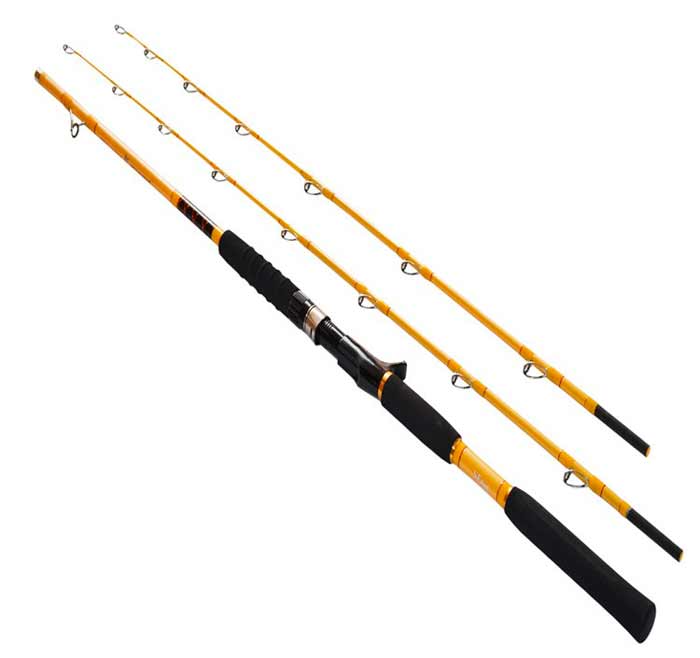
Common types of fishing rods:
- Bolognese. Size - from 4 to 7 meters, used in fishing in slow currents or in standing water. Hard models are designed for long casts, while soft ones respond better to small fish biting.
- Fly feathers. They are characterized by minimal weight with a maximum length of up to 8 m. The design does not provide rings for fishing line, and there is also no possibility of installing a reel. The area of application of this fishing equipment is fishing by hand. Their equipment is replaced quickly due to its simplicity.
- Match. Needed for long casts, characterized by large mass. Fishing gear of this type consists of three parts. A special feature is the use of a sinking fishing line. Maximum length – up to 5.5 m.
How to choose fishing hooks for a feeder - sizes and numbers
When choosing, you need to take into account the rigidity of the rod and the correct selection of fishing line. Telescopic models can be equipped with various types of reels.
Fishing with spinning rod
Spinning is also an ancient fishing rod. And the prototype of the modern spinning rod was probably a tackle in which a fishing line from the sinew of some animal was tied to a flexible pole, and at the end of this pseudo-line there was a bone hook with a fish tail, a tuft of wool or a roughly processed wooden bait. Ancient man was observant, since the harsh conditions of life simply forced him to be smart and notice everything. And more than once, apparently, I witnessed how fish hunted for an insect, a fly, or even a leaf from a tree that had fallen into the water. And there was only one conclusion: you need to attach something to the hook so that it definitely moves in the water. Given the abundance of fish in those days, even a short retrieve of some simple bait, which was done using a fishing rod, was probably enough. Even nowadays, you can successfully catch perch with small twisters and rippers by holding the bait next to the boat with a regular fishing rod. Checked...
The simplest spinning baits, which are probably centuries old, are oscillating spoons, which accurately or approximately imitate live fish. The main thing is that something shines in the water and moves. And the oscillators have a very attractive game, swaying from side to side, falling down and rising, oscillating and briskly wagging from side to side. Well, a natural fish, and, as it seems, probably to a predator, is sick or injured, since its movements are too hectic, which is due to the shape of the oscillating spoon.
The success of oscillating spinners lies in the simplicity of wiring. And even a novice spinning angler can catch pike, pike-perch and perch on a spoon using the most basic, even casting. In summer, medium and light baits are usually used, and in autumn - the largest and heaviest ones, increasing the speed of the retrieve. When fishing in the fall, they already use bottom fishing or step fishing, when the spoon jerkily rises above the bottom and falls back down again. In summer, the jerking method is also used, but in the middle and upper layers of water. This method is called twitching.
Rotating spoons, which are called “spinners,” are no less popular among spinners and attractive to the predatory fish population. Perches are especially eager to jump on the turntables. Under certain conditions, most often in the hot summer, spinners are the most effective among artificial baits. The mesmerizing moment of the fish consists of the rotation of the metal petal on the axis of the turntable. Fish are also attracted to the details of the spoon, such as the bell, the core, and the fly on the hook.
Intellectual or smart fishing is called spinning fishing with various wobblers. And here you already need knowledge of wiring, the ability to correctly use twitching, feel the bait and adjust its course so that it moves attractively and looks like a live fish.
Wobblers can be floating, of average characteristics, that is, suspended in the water column (suspending,) and sinking. But floating baits are also different. Some move only at the top, others are able to go deep to a level in the water column that is accessible to this bait and depends on the size and angle of the blade. Each of these species is designed for special fishing conditions and for a specific season. Floating baits and minnow class suspenders are more often used in the summer, sometimes in the spring. Sinking and deep-plunging wobblers are used in the fall and in trolling, which will be discussed later.
In the spring, when predators begin to fatten after spawning, fat-type wobblers are often effective, short, “thick”, rattling with shot inside, like children’s rattle toys, very active. In short, each month of the year has its own attraction. This rule, of course, is general, since sometimes any wobbler can be in demand at any time of the year. An example is rattlin wobblers. They are even used for ice fishing.
Jig baits can also be called one of the most popular baits in catching predators using a spinning rod. And the most commonly used are silicone baits, and more recently edible rubber baits. These are twisters, vibrating tails, various rubber frogs and crayfish, Hoagi Shrimp and Hoagi Hog baits made of edible rubber. Most often in this type of spinning fishing, jig heads and “eared” sinkers are used, on the hooks of which the above baits are attached.
Silicone baits have a great advantage over other baits in that they work universally against pike, zander and perch, and at the same time are much cheaper than spinners and wobblers. They are very diverse in color, fast and active. Most often, the jig is used for bottom step-by-step fishing for pike perch and autumn pike. Artificial worms and Long John lures are just as successful, also rigged on a jig head. They can also serve as the simplest non-hook hooks, if the hook is hidden in the rubber body of the worm. Offset hooks are most suitable for this purpose.
In addition to silicone and edible rubber, foam rubber fish are attached to jig heads and other sinkers with hooks. These are also very successful lures with nimbleness and fast multi-phase action. In addition to the fact that foam rubbers are capable of active play, they also make movements that are attractive to predators, simply falling to the bottom, and this happens when, instead of a jig head, foam rubber baits are attached to hooks connected to flat lentil sinkers. When it falls to the bottom, the sinker stands on its edge, and then slowly lies on the ground with its flat part. At the same time, the foam rubber makes one more final moment of the game, which can often be called the moment of truth. At this phase, bites from large pike perch most often occur.
Spinnerbaits occupy a special place among spinning lures. These clumsy-looking baits of a strange design, however, are very attractive to predators, obviously because they consist of three elements at once, where the active ones are a rotating petal, like a spinner spoon, and a soft bait on the hook. Here, on the bait, is the sinker. In addition to their effectiveness, spinnerbaits are true hook-free baits. The hook is protected from snagging on grass and snags by a metal shackle located in front of the hook.

When fishing with a spinning rod in the fall, the main attention is often paid to polyurethane foam baits and various streamers and goat wool lures. These baits are distinguished by good flight characteristics, and wabiki also blow bubbles very noisily and spectacularly, releasing the air accumulated in the fur, which is very attractive to the greedy and gambling autumn predator.
Surface baits are included in a separate section. They are used most often in the summer, in the heat, although professional spinning anglers often fish with these baits for almost the entire open water season, right up to winter. Some of the surface baits are non-snagging, for example, gliders that can move right through the burdocks of the water lily. In addition to the long-known stickbaits, poppers, torpedoes, and gliders, American lures with a crazy character also appeared. That’s what they’re called – crazy crawlers, loosely translated something like “crazy swimmer” or “crazy crawler”. Fishermen from overseas catch their perches - basses - on these crazy swimmers, but it turns out that domestic pikes and perches are not averse to attacking such noisy baits splashing on top.
Surface baits are intended for fishing in thickets of grass, almost at the surface, where predators tired of the summer heat stand in the shade of water lilies, reeds and coastal thickets. And this makes such fishing exclusive, without competition from other anglers with spinning rods. Not everyone will fish in the grass, especially from the shore, using conventional spoons or spinners.
Read the separate article on our website about fishing with a spinning rod.
— it describes in detail some aspects of fishing.
Fishing technique
Wiring
Retrieving the bait is the basis of spinning fishing. The rod experiences certain loads at this time. In order to reduce them and not damage the entire gear, you must follow the rules:
- When retrieving, keep the rod at an angle of 45 degrees to the horizontal;
- never lower the rod in line with the fishing line;
- Do not reel in the line when the rod is vertical.
- observe the work of the fishing line when reeling in. Poor quality and improperly tied baits can twist the line so much that it fails.
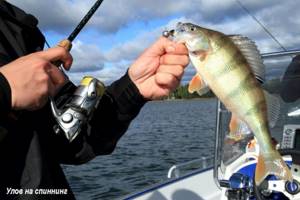
Types of postings
During the retrieve, the spinner's attention is focused on the movement of the bait. This is the most important process in spinning fishing. Imitating the movement of the bait like a live fish, making it grab it - this is the beauty of spinning fishing.
Types of postings:
- uniform wiring is performed by simply reeling in the fishing line with a reel at the same speed without stopping or jerking. When leading the bait at one depth, the rod is held almost vertically, but as the bait is attracted, the rod is lowered to the water. This will ensure a uniform speed of movement of the bait;
- jerk wiring is carried out by unevenly reeling in the fishing line. The change in speed can occur over different periods of time. For example, a slower winding of the fishing line onto the spool indicates that the bait is sinking to the bottom. And when the speed of rotation of the spool handle increases, the bait begins to play intensely and can jump to the surface of the water. To deepen it, you even have to lower the tip of the rod into the water.
After casting, the bait is given time to sink to the bottom, wait 3-4 seconds and pulled along the bottom, then, lifting the rod, the bait is torn from the bottom and spent several meters in the water column, then lowered again;
- stepwise wiring is carried out at the very bottom. It is more typical for soft plastic baits.
The twister, or vibrating tail, falls to the bottom and continues to play. It is attractive, as is the case with uniform wiring. This wiring is more suitable for pike perch and catfish, which feed from the bottom;
- intermittent “stop and go” wiring comes from uniform wiring, divided into certain periods of time in which the movement of the bait is stopped. Suitable when using wobblers;
- wave-like wiring is usually used when fishing for pike. With such wiring, the bait looks like a confused fish that does not know where to swim.
When performing any wiring, be sure to pause with varying time delays.

At this time, the number of bites increases. Over time, the spinning angler will learn to determine these very intervals by stopping the movement of the bait.
Fish hooking
Hooking is a joyful and exciting event for an angler. Not everyone can keep calm when the fish is already on the hook. Hooking is preceded by a blow to the bait, this is especially noticeable with pike. It takes experience to notice everything on time. If a bite has already been noticed, then you need to immediately hook it. Sharply pull the rod slightly upward, keeping the line taut. You will feel a pleasant heaviness on your hand.
Fishing
They “drive” the fish and try to tire them out. It works well when the fish is at a distance and does not see the angler. On the contrary, when fishing from a boat, the fish gets scared and can break the tackle and dive under the boat.
Fishing should be done by pumping, alternately pulling with a reel and lifting the rod, the fish is brought to the shore. The spinning rod makes swinging movements from vertical to horizontal.
Trolling fishing
This method of fishing, which has recently become popular and is called a foreign word, has, however, been known in Russia for a long time under the more familiar name - “path”. But if earlier they pulled some kind of oscillating spoon behind a regular rowing boat, now trolling involves more advanced fishing, where the boat is equipped with strong spinning rods with multiplier reels. And behind a powerful small vessel several baits are pulled at once. This has become the reason that many anglers consider trolling to be an unsportsmanlike form of fishing.
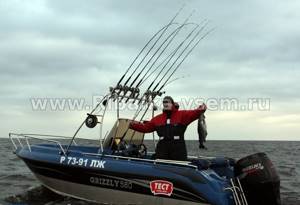
For trolling, special wobblers with a long blade are usually used. These baits are called dipraners. Such wobblers are capable of diving to a depth of more than three meters, which ordinary wobblers cannot do. But such deep-sea baits create strong resistance. That’s why we need spinning rods with a large dough and equipped with a multiplier reel. Other spinning lures are rarely used in trolling because they will be pushed to the surface. The largest wobblers are used for trolling. Their length together with the shoulder blade can be 20 cm.
Read the article - trolling
- for detailed information about this type of fishing.
Fishing on a feeder
The English donka - feeder - appeared in Russia not so long ago, although domestic fishermen have always fished with similar gear. But the feeder is already a separate type of donkey, sensitive, rather complex, with its own characteristics. The main difference between the Feeder-Fishing tackle is that the feeder is both a sinker and is located on the main fishing line of the tackle. And the bite is determined by the flexible tip - quivertip-fishing. Typically, a set contains several tips of different elasticity, which are designed for the fishing conditions in a given place and the weight of the feeders.
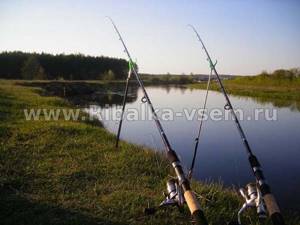
Feeder rods are also divided into classes. Winkelpickers are the lightest fishing rods. Their length is 2.5-3 meters, the tests are small, for relatively light feeders weighing 20-60 grams. Often, instead of feeders in pickerel fishing, sinkers are used. Medium rods of the medium class are used most often and are universal in feeder fishing. They can be used on bodies of water with and without current, that is, on ponds, lakes, rivers and reservoirs. The maximum weight of feeders for these Medium Feeder class rods is 120 grams, but feeders weighing 40-100 grams are usually used. The length of the rod is 3.3-3.9 m. There is special gear for fishing in the spring and on very strong currents of a large river. These are heavy and extra or ultra heavy class rods. They are capable of ultra-long casts and delivery of feeders weighing 150-250 grams. There are other rods that are used quite rarely, but are very suitable in their parameters for fishing on a quiet pond and catching crucian carp. The very sensitive Swingtip tip is attached to a hinge and sensitively shows the most timid bite of a golden carp.
Feeders also vary not only in weight, but also in type, which determines the rate at which the bait is washed out. These are end feeders, sliding feeders, on a leash, closed, semi-closed and open. Recently, open-type feeders are most often used, and the rate of leaching is regulated by the viscosity of the bait and the density of its packing into the feeder. There are also flat, open-type feeders that lie well on the muddy bottom. These are Method and Flat feeders. The bait is formed in special molds, where leashes with hooks are placed in advance, and then placed in the feeder. Usually, ready-made bait mixtures labeled Feeder are used, but many fishermen prepare porridge fillers with their own hands and add ready-made feeder baits to them.
The leashes are tied quite long, often more than 1-1.2 meters. Methods of connecting the leash to the main line are called looping. This is Steve Gardner's paternoster and asymmetrical-symmetrical loops. The easiest way to connect the leash to the main line is with a plastic anti-twist. The fishing line moves freely in a tube connected by a clasp and a swivel to the feeder. An even simpler and no less effective way to connect the leash is using a triple swivel installed above the feeder. Braided cord is usually used as the main line, and monofilament line is used for leashes.
The principle of fishing with a feeder is to find a catchy edge, feed the fishing point and, in fact, have fun fishing. And to do this, first, the edge is always located using a marker weight, the fishing line-cord is fixed in a clip on the reel or marked with an alcohol marker so that the casts are the same length, then the desired direction of the casts is determined according to the landmark on the opposite bank. As bait and bait, as in a float fishing rod, worms, maggots, bloodworms, various wood and aquatic larvae, canned corn, semolina and mash, bread, pearl barley, peas and other vegetable baits for certain fishing conditions are used.
All aspects of feeder fishing are described in more detail here
.
Feeders
Needed for catching non-predatory fish. Structurally very similar to the donks described above, the difference lies in the frequency of casting. This should be done every five minutes, regardless of whether there is a bite. Externally they are similar to spinning models, but have their own classification according to class, length, and action.
Features of catching pike in the spring with a spinning rod: choice of bait, fishing line, place and time
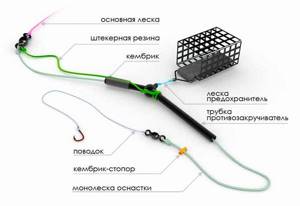
This tackle has the following features:
- Selection by test. Depends on the weight of the feeder - from 60 to 200 g.
- The length of the rod varies from 3.3 to 4.6 m;
- The coils used are inertialess.
The recommended spool volume of the latter is from 3000 to 6000. Installation of the cord or fishing line can be carried out in one of three ways - symmetrical, asymmetrical, inline or Gardner loop. The type of fish feeder is open, of various shapes. Recommended manufacturing material is plastic. In the latter case, you definitely need a weight.
Fishing on a donk
The simplest and most successful gear for fishing in strong currents and depths are donks. These can be bottom fishing rods using a rod and a bite alarm in the form of a float raised to the tip, as well as using a bell or bell at the tip of the rod. But for night fishing for burbot, the most primitive, but no less effective donks are often used, consisting of a main fishing line on a reel, one or two leashes with large hooks and a heavy sinker. The bite signal is a large ringing bell, the sound of which can be heard far in the silence of the autumn or spring night. Such gear is called zakidushki.
Side donks are also very popular among anglers. These are short side rods or winter fishing rods for trolling, equipped with a feeder feeder, a leash with a hook and a bite alarm in the form of a feeder bell or a small bell.

Also among the very catchy donks is the popular “ring”. Its design feature is that the cord of the massive feeder is connected to the donkey equipment, and the leashes with hooks are always in the direct stream of the washed-out bait. Due to its effectiveness, some fishermen consider the “ring” to be a poaching tackle. However, at one time “ringing” was actually prohibited by the Rules, but now there is no ban, at least in most regions of Russia. Many more different bottom gears can be called derivatives of classic donkeys, one of which is the running donka. This is an ordinary bottom with a pear-shaped sinker, on the narrowed part of which a swivel is attached. Above the sinker, a meter-long leash with a hook is tied on a triple swivel. The tackle is used both for catching “white” fish, when the hook is rigged with a worm, maggot and other baits and baits, and for fishing for predators, when the hook is baited with live bait, cut fish or artificial bait. The fishing technique involves moving a sinker evenly or jerkily along the bottom, above which some kind of bait oscillates in the current or in the oncoming water stream of a standing reservoir. In strong currents when fishing from a boat, such a running bottom is used to periodically dump the sinker and bait downstream. And then the tackle is selected by the fishing line or using a reel, forcing the sinker and bait to move against the current towards the boat. At the same time, short pauses are made, during which fish bites often follow.
Visit the donk fishing
. From it you can study this method of fishing in more depth.
DIY gear for open water fishing
Self-made gear is more convenient to use than store-bought gear. In this case, they can be completely customized. It is more convenient to fish on an open surface with your own gear, the main thing is to make it correctly.
Making a float fishing rod
Fishing rods of this design are called fly rods. Some of them are equipped with coils, although they are not particularly necessary. It is better to attach the fishing line to the end of the rod. The casting distance depends on the strength of the swing.
The presence of a reel makes the tackle heavier. It is preferable to use it for storing fishing line and not attach it to tackle.
Manufacturing of equipment:
- If a reel is used, then the fishing line is passed through all the rings, and the end, using a double loop, is tied to it. The unnecessary part is cut off. If there is no reel, then the fishing line is attached directly to the top point of the rod.
- If there is a reel, the fishing line is wound around it. If it is not there, then the length of the fishing line should match the length of the fishing rod or be 0.5 m longer.
- The line is threaded through the top ring of the float. Along with it, seals or cambrics are put on, which grip the lower part of the float.
- The float is moved up, and weights in the form of pellets are attached. There should be such a number of them that when testing the float, only its upper part stands out on the surface.
- Leashes about 20 cm long are attached to the fishing line. Their number can be 2 - 3 pieces.
- The ends of the leashes end with hooks.
Fishing with such gear occurs from the shore. The depth of the reservoir varies from 0.5 to 15 m. Casting range is 5 to 8 m.
DIY feeder equipment
Bottom fishing is carried out using feeder equipment. The fisherman watches the fish touch the bait.
You can make it yourself.
It has varieties:
- Paternoster. The fishing line contains a number of loops. Leashes with attached hooks and bait are attached to them.
- Asymmetrical and symmetrical loop. An asymmetrical loop is obtained when 1.5 m of fishing line is folded, making one end 10 cm longer. Twist the double fishing line up to 15 cm, then tie a knot. A swivel is attached to one end. It turns out that the long side is 50 or 70 cm, and the smaller section is 30-60. With symmetrical feeder equipment, the lengths of the ends are the same.
- Helicopter. A swivel is attached, which has a clasp for the feeder. To seal the swivel, a cambric is put on. The distance to the feeder ranges from 5 to 20 cm.
- With anti-twist. So, they call it a curved tube with a fishing line inserted. It is stopped by a damper bead. Next, a swivel with a leash is attached.
- Combine. The basis is also an anti-twist. Then the fishing line with the feeder is attached to the swivel.
- Inline. The swivel has a clasp with a stopper, and then a loop is formed for attaching the leash. The feeder is connected via a carabiner.
Spinning rod assembly
A spinning rod is very convenient for fishing on a flat surface.
Its assembly proceeds in the following order:
- I use glue and attach guide rings to the rod.
- These rings must be clearly located in the axis. Deviations are not allowed, since the line will rub against their sides. This will affect your casting distance.
- As a rule, the rod is sold with a reel seat. This is where the coil is attached.
- The fishing line, passing through the rings, is fixed with a bobbin and then wound onto a reel.
- The last stage is attaching the swivel.
Spinning is considered a universal tool for catching both large fish and small and medium-sized ones.
Making your own baits

When making bait with your own hands, you should remember that it is prepared for individual fish species. It should attract their attention with aroma and color.
Bait recipes:
- Porridge. After keeping the cereal in boiling water for 15 minutes, add aromatic elements: anise, dill, camphor.
- Simple earthworms.
- Potatoes and bread. The potatoes are boiled with the skins on until partially cooked. The bread is cut into small pieces and placed on a hook together with the potatoes.
- Bread and honey. These substances are taken in a ratio of 10:1. A well-mixed mixture is an excellent bait for crucian carp.
- Old bread. Dough is made from it. The crust is cut off and the flesh is softened in water. The required amount of sugar is added to obtain a solid consistency.
- Electronic lures. They are used in fishless areas. The fish swims not only based on the smell, but also on the sound effect.
Important to remember! That each body of water has its own characteristics. When fishing in an unfamiliar place, you need to study the habits of the fish in order to correctly decide on the type of bait.
Fishing on a boat
This ingenious tackle was not invented for children's games in a river or pond, but for delivering bait, bait or artificial bait to a certain distance from the shore without casting. The “boat” is also called a “sleigh” or “catamaran”. This is a small flotation device that can be quickly made even from two empty plastic bottles. But usually the “ship” consists of two streamlined float plates, similar to the hulls of ships or catamarans.
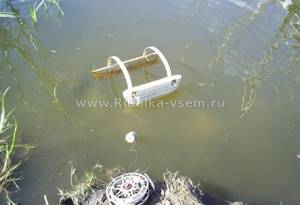
They are made from light wood like balsa or dry linden, as well as from foam plastic and even from scraps of plastic doors. Sometimes the keel of the main hull is loaded with lead for stability or a metal plate is attached below.
The steering wheel of this vehicle is a metal plate attached to a spring or elastic band, which, when the fishing line is tensioned or loosened, turns in one direction or the other. This causes the “catamaran” to move from the shore or towards the shore by changing the angle of the hull in relation to the flow of the oncoming current. Moreover, when moving from the shore, it is possible for the “catamaran” to overcome a small current, that is, the “ship” can even sail forward against the current, just as a sailboat moves on tacks against the wind. “Sleighs”, “ships”, “catamarans” with such control are called reversible. Conventional “boats” are equipped with only two loops on both sides of the front body or a wire bow along which a runner with fishing line runs. When pulled in one direction or another, the slider also shifts, causing the “sleigh” to move towards the shore or, conversely, towards the stream of the river.
Typically, a fast-action spinning rod is used for boat fishing. One or more leashes with hooks are placed on the main line, on which mayflies, grasshoppers, flies are attached, or artificial flies are tied to the leashes. These light baits move along the very surface of the water or in the surface layer if the baits are relatively heavy. And such baits are most often attacked by asps, chubs, and ides. Sometimes the boat carries small live bait along with it. Then perches and pike can become prey.
Read the article fishing on a boat
, to get acquainted with this method of fishing in more detail.
Fishing with a circle
Live bait fishing with mugs is considered very exciting and productive. The main prey are pike and pike perch.
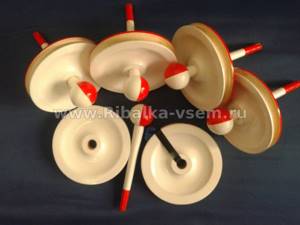
Most often they are caught with circles in reservoirs and lakes. On rivers, they choose places with weak currents and quiet, deep bays without an abundance of aquatic vegetation. The reason for this choice is that active circles, that is, freely moving around the reservoir, will often cling to the grass when there is a lot of it in the reservoir. Walking long distances across the reservoir, the mugs fish all the places where a predator can stand. But you need to know the topography of the bottom of the reservoir, noting holes and shallows in your memory or in your navigator. It is best to fish in light winds, moving the boat behind the circles at the greatest distance possible, so as not to lose sight of the gear.
There are floating mugs that are anchored somewhere near an island or strip of grass. Such circles are used where there is too much vegetation or the reservoir has a very uneven bottom topography. On some forest lakes, densely overgrown with water lilies and hornworts, there is simply no alternative to standing mugs other than flyer girdles.
Mugs are made from compressed foam or plastic. A plastic pin is inserted into the hole of the circle in the center, which serves as both a keel and a clamp for the fishing line. At the bottom of the keel there is a bright ball. And at the top of the keel there is a groove. The fishing line is thrown there, and then it is lowered and fixed on the side of the mug in a small recess. While waiting for a predator to bite, the circle moves across the pond with its red side up. During the grip, the circle overturns and then turns white in the dark water in the morning. It's time to swim to the tackle!
A nylon cord or braid is wound around the circle. A monofilament fishing line is tied to the end of the cord. And then, as usual - sinker, leash, double.
Visit the circle fishing
and you will receive detailed information on how to fish with this popular fishing tackle.
Briefly about spinning fishing tactics
Spinning fishing tactics involve choosing fishing spots. This must be done before fishing.
Typically, a catchable area should stand out in some way:
- a place with snags, sunken trees;
- place of change in current (whirlpool, sharp bend);
- deep dams, mill whirlpools;
- places with trees hanging over the water.
Immediately after choosing a place, you should make close casts, fishing around you. Sometimes the fish stands right at your feet. Just check the nearby places, then move on.
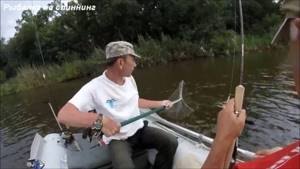
When fishing in small bodies of water and narrow rivers, use a short rod (up to 2.4 m) and a fishing line with a diameter of 0.2 mm. There is no need to use heavy baits, they will not have time to prove themselves in such conditions.
The spinner must understand that predatory fish grab their prey from hiding. Having grabbed it, they rush back. And if they succeed, then the fisherman is left with nothing.
Flashing
Spoons are now one of the main lures produced by many fishing equipment manufacturers. After all, she is able to fish in spring, autumn, and winter. All spoons are divided into oscillating and rotating. The so-called oscillators are more popular. Especially when fishing for pike.
They should be selected according to the place of fishing. For example, in low light conditions of a pond or in muddy water, a light-colored spinner is selected. On the contrary, in the summer, when there is no rain and the water is clean, they select a dark-colored lure.
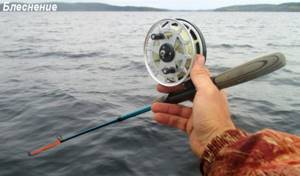
One of the ways to fish with a spinning rod is from a boat in a plumb line. This method is suitable for deep, clogged areas. It is simply impossible to fish there with a simple cast.
Twitching
This is the same jerk wiring. Jerks are made with the spinning rod, while the reel rotates at the same time. The bait moves in leaps and bounds. This wiring is done with a fishing rod, the reel picks up the slack in the fishing line.
Twitching technique:
- two jerks are made with the rod;
- at the same time the reel removes the line;
- A pause of 2-3 seconds is maintained, jerks are made with the rod again.
Jerking
This is bait wiring, similar to twitching. Only here spinning fishing is more intense for the angler’s hands. Jerks are made with a greater amplitude, up to 1 meter. The movements of the bait are similar to a sick fish, which ultimately provokes a bite. Fishing with a spinning rod with this type of fishing forces the angler to move a lot.
Jig
Or stepped wiring. To perform this task, the industry produces jig heads. To obtain a jig bait, you need to pull a soft silicone bait onto the jig head. Usually twisters, vibrotails, and fish are used. During the retrieve, this jig bait literally knocks on the bottom. When performing a jig, the bait is twitched with a reel.
Fishing for fish
These are the most uncomplicated gears and can be equated to hooks due to their ingenious simplicity and simultaneous success, but they are installed from the boat. Postavukha is most often used for catching predatory fish and live bait is attached to the hook of this tackle. In addition, dead sprat is a very good bait for catching pike perch. But at the same time, on carp ponds, fishermen are very successfully used for schooling catching of domesticated carp, of course, where this is permitted, if the pond is paid or has economic importance, and also if there are no restrictions in local regional rules.
But basically the baits are live bait gear. Their design is a “couldn’t be simpler” type scheme. A float swings on the water - most often a plastic bottle; a thick main line goes into the water column to the bottom. And at the bottom there is a sinker weighing at least 150 grams. In fairly strong currents where pike perch can hold, heavier weights are also placed, since the caught fish can also contribute to the current and in this case the tackle will have to be looked for in another place, most likely, further down the river. Above the sinker, a metal leash with a double is tied to a triple swivel. In addition to live bait and sprat, even pearl barley meat is attached to it. Catfish love these mollusks.
Read the article: catching fish with baitfish
to learn more about this type of fishing.
Fishing on a girder
Sometimes this old Russian tackle outperforms the most sophisticated and expensive spinning baits in terms of catches. And the reason for such success is the most elementary - the fish is alive on the hook of the girder. It has a natural shine, shape and, of course, smell, and also propagates vibrations, the frequencies of which are familiar to all predators and, in fact, their vibration-wave receiver is tuned to these waves. The lateral line of the baitfish, which is a similar relay, lets the predator know for sure that food is nearby. Artificial baits, especially high-frequency ones, also transmit these waves, but a low-active predator does not always react to these unnatural frequencies.
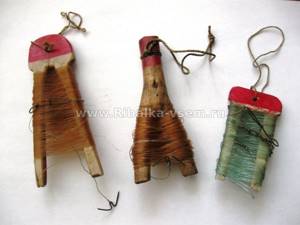
Fliers are made from the forks of dry coastal bushes or from plastic. A thick fishing line in the form of the number “8” is wound around the flyer. This winding prevents the cord from twisting, on which the pole is suspended from the pole. Zherlitsy are usually installed near aquatic vegetation, where predators hunt small fish in pursuit, like perch, or set up ambushes, like pike.
The pole of the girder is stuck at an angle of 45 degrees right in the window among the water lilies or along the edge of the grass. The main thing is that the live bait cannot reach the grass in a jerk. Then he will stand in the vegetation and no pike will be afraid of him. To prevent the live bait from twisting the fishing line over the pole, the angle of installation of the pole is precisely 45 degrees. Some fishermen try to place girders at a depth of more than 3 meters, supposedly the pike is larger there. But the pole at such a depth needs to be very long or it will have to be placed almost at a right angle, which is guaranteed to mean that the bait will overwhelm the fishing line and will stand close to the pole, inaccessible to the predator. In this case, there is no need to install vents at depth. In the summer, pike go out to hunt in the shallowest waters, where grass usually grows, in which small fish are kept - food for the predator.
The baitfish is hooked under the dorsal fin, as well as under the dorsal fin and lip, the leash is pulled through the gills and the hook is inserted into the baitfish's mouth, and the baitfish is fastened with a sharp pin-fastener.
Zherlitsa often provide the main catch, while fishing rods and spinning rods are often inactive during sluggish bites.
In the article fishing for girders
You will learn in more detail how to properly fish with this device.
